The serval cat, a lesser-known predator in Kruger National Park, is a master of stealth and agility. With long legs for navigating tall grass and radar-like ears for detecting prey, it can leap three meters to catch birds mid-flight. This elusive, nocturnal hunter embodies the mystery of the African bush, making any rare sighting an unforgettable experience.
Nighttime Wildlife in Kruger: Exploring the Nocturnal World

Kruger National Park transforms into a mysterious nocturnal world at twilight, revealing its captivating nocturnal creatures, each uniquely adapted to the dark. The elusive leopard, the independent African wildcat, the acrobatic bush baby, the stealthy spotted hyena, and the enigmatic civet are just some of the fascinating species that embody the vibrancy and diversity of Kruger's nightlife. This nocturnal safari offers a unique experience to wildlife enthusiasts, promising an unforgettable adventure into the heart of South Africa's nocturnal beauty with Needles Lodge.
As twilight descends over Kruger National Park, the landscape transforms, ushering in a mysterious nocturnal kingdom. This hidden realm, abuzz with subtle sounds and shadowy movements, is a sanctuary for the park's most captivating nocturnal creatures. The shift from daylight to darkness in the African wilderness is more than a mere change in illumination; it's a profound alteration in life's tempo. The nocturnal inhabitants of Kruger, each with their distinct survival tactics and behaviours, are perfectly adapted to thrive in the dark. Our journey into the night at Kruger reveals the park's secretive and mesmerising species, offering wildlife aficionados a unique experience even after the sun dips below the horizon.
1. The Elusive Leopard
In the moonlit realms of Kruger National Park, the Leopard stands as a symbol of agility and grace. These stunning animals, with their distinctive rosette-patterned fur, glide through the night, exuding power and poise. As nocturnal sovereigns, they rule the darkness with a silent dominance felt throughout the bush. Their elusive nature adds to their enigma, making them a prized sighting for wildlife enthusiasts during nocturnal expeditions.
Physical Description: Leopards are known for their impressive physique and striking coats, epitomising feline elegance and might.
Habitat: They thrive in a variety of park terrains, showcasing their adaptability.
Interesting Facts:
- Leopards are solitary by nature, often found in the dense foliage of Kruger.
- Skilled climbers, they frequently stash their catches in trees.
- Their unique spot patterns are as individual as human fingerprints, contributing to their unique appeal.

2. The Independent African Wildcat
With the arrival of night over Kruger National Park, the African Wildcat steps into the spotlight. This solitary figure, reminiscent of domestic felines, embodies independence and primal elegance. In the nocturnal silence, it wanders with a subtle yet definitive presence, reflecting its untamed lineage and adaptability.
Physical Description: More robust and sleeker than domestic cats, they feature a distinctively striped tail.
Habitat: Favours the park's dense vegetation and woodlands
Interesting Facts:
- Expert solitary hunters, specialise in catching birds and rodents.
- Ancestors to all domestic cats.
- Their adaptability and intelligence play a crucial role in maintaining ecological balance.
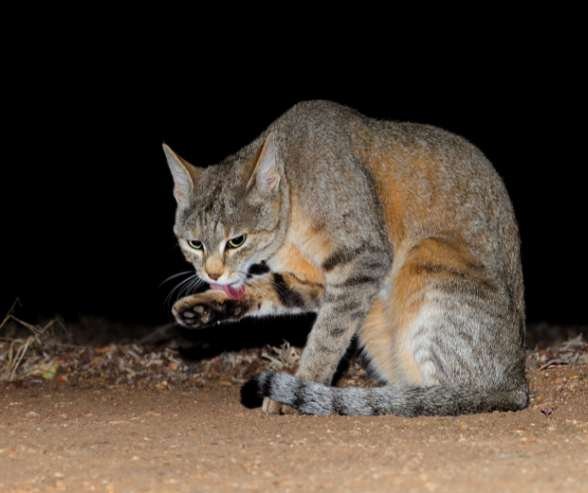
3. The Acrobatic Bush Baby
At dusk, the Bush Baby emerges as the acrobat of Kruger's night sky. These small, endearing creatures, with their large, soulful eyes, are a display of agility and charm. Their tree-to-tree leaps showcase the vibrant spirit of Kruger's nocturnal life, adding a layer of enchantment to the park's nightly ambiance.
Physical Description: Small, furry, and characterised by large, expressive eyes.
Habitat: Prefers areas rich in trees.
Interesting Facts:
- Renowned for their impressive leaping abilities.
- Their exceptional night vision is crucial for nocturnal activities.
- Their high-pitched cries are a distinctive sound of the African night.
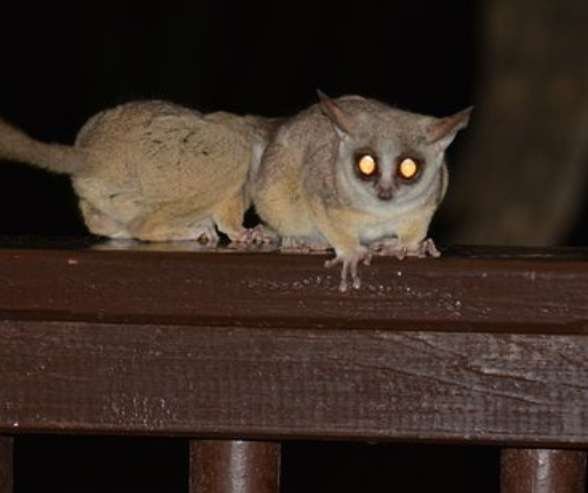
4. The Stealthy Spotted Hyena
In the soft lunar light, the Spotted Hyena, often misjudged, asserts its role in Kruger's nocturnal order. Known for their unique vocalisations and cunning, these hyenas navigate the savanna, demonstrating their resilience and intelligence. Their presence adds a distinct element to the park's night-time ecology, challenging common perceptions.
Physical Description: Recognisable by their spotted coats and formidable jaws.
Habitat: Comfortable in various Kruger environments.
Interesting Facts:
- Contrary to popular belief, they are skilled hunters.
- Possess one of the strongest bites among animals.
- Their matriarchal society is unusual among carnivorous species.
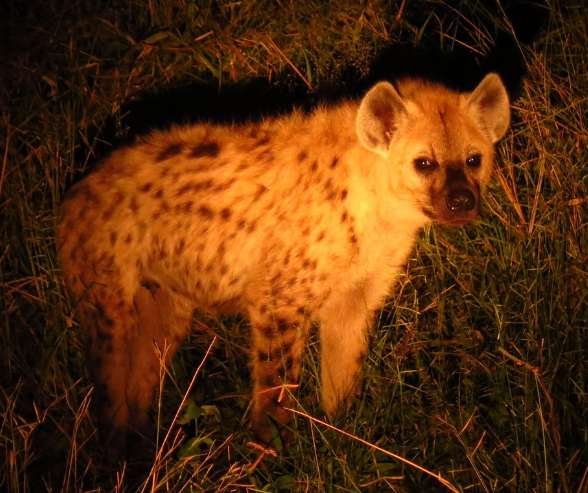
5. The Enigmatic Civet
As night cloaks Kruger National Park, the mysterious Civet embarks on its nightly forays. These solitary beings, with their eye-catching patterns, traverse the undergrowth with a secretive elegance. Their presence is often hinted at by brief shadows or their unique scent, making each encounter a rare and fascinating experience.
Physical Description: Distinguished by striking patterns and a distinctive musky odour.
Habitat: Thrives in diverse park environments.
Interesting Facts:
- Known for their unique scent used for communication.
- Their omnivorous diet includes fruits and small vertebrates.
- Due to their omnivorous diet that includes various fruits, African Civets play a significant role in seed dispersal. The seeds they consume are often excreted in different locations, aiding in the spread of various plant species.

Embarking on this expedition into the nocturnal wonders of Kruger National Park, we hope to have sparked your curiosity and imagination. Now is the ideal time to turn your interest into an extraordinary experience. Plan your next adventure with Needles Lodge, where each night unveils new marvels and discoveries. South Africa's nocturnal beauty awaits your exploration, and we are here to ensure your journey is safe, exceptional, and truly memorable. Join us at Needles Lodge for a safari that unveils the mysteries of the African night, an adventure you won't forget.

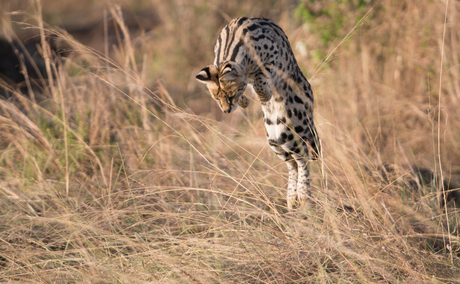

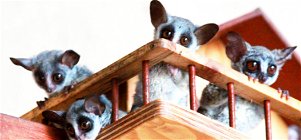
Share This Post